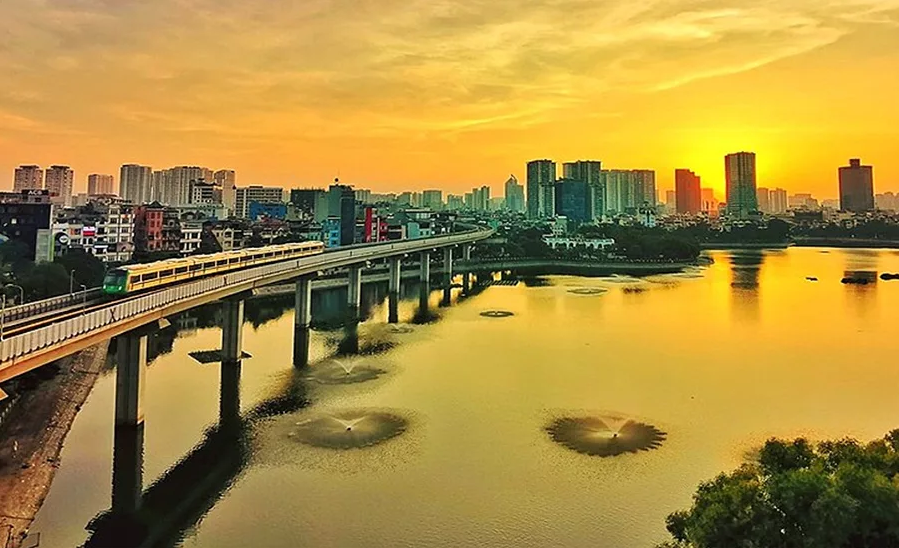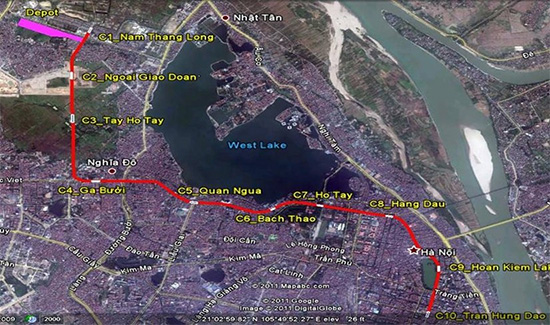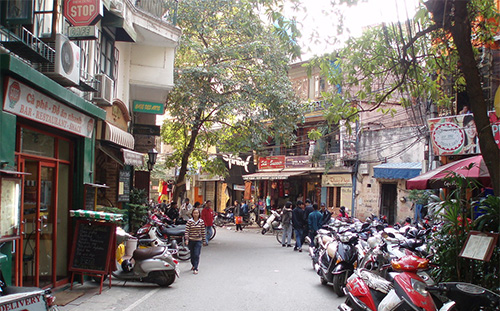Hanoi Breaks Ground on $1.3B Metro Line 2 Segment Through Historic Core
 Hanoi has broken ground on the 10.84-km Nam Thang Long–Tran Hung Dao section of Metro Line 2, a $1.3-billion investment officials say will advance a long-planned urban-rail spine through the city’s dense, historic core.
Hanoi has broken ground on the 10.84-km Nam Thang Long–Tran Hung Dao section of Metro Line 2, a $1.3-billion investment officials say will advance a long-planned urban-rail spine through the city’s dense, historic core.
The Oct. 9 ceremony at the Xuan Dinh depot marked the official construction start for one of Vietnam’s most technically challenging infrastructure projects. The new segment will include 1.94 kilometers of elevated guideway and 8.9 km underground, with 10 stations from Xuan Dinh south to Tran Hung Dao.
In remarks at the event, Hanoi People’s Committee Vice Chairman Duong Duc Tuan called the milestone “a critical beginning for Hanoi’s modern, high-capacity transit system,” framing the line as central to the city’s effort to ease congestion and modernize mobility.
Following the ceremony, work began with ground improvement at the 11.3-hectare Xuan Dinh depot. The Metropolitan Railway Management Board awarded the first contract to local firm FECON for roughly $7.9 million. The 499-day job will stabilize soil and prepare the site for full depot construction.
The MRB, which serves as the city’s executing agency, said the project is financed by development assistance from the Japan International Cooperation Agency (JICA) and local counterpart funds.
Director Nguyen Cao Minh confirmed the scope and station count, emphasizing the Japan–Vietnam partnership. State English-language outlets put total investment at nearly $1.33 billion and confirmed the elevated-and-underground split.
Approvals and Financing Framework
The section running through Hanoi’s Old Quarter and around Hoan Kiem Lake is among the most sensitive in the system.
 The$1.3-billion Metro Line 2 includes the Nam Thang Long–Tran Hung Dao alignment, a 10.8-km corridor with ten stations and tunneling beneath the Old Quarter. Photo courtesy of FECON
The$1.3-billion Metro Line 2 includes the Nam Thang Long–Tran Hung Dao alignment, a 10.8-km corridor with ten stations and tunneling beneath the Old Quarter. Photo courtesy of FECON
In August, the city approved a detailed route and station-location plan for the stretch. Known locally as a “1:500 plan,” the final planning stage that fixes alignment, station boundaries and land-acquisition lines through the Old Quarter.
Formalized Aug. 26, the step clears the way for full-scale construction beneath heritage streets toward Tran Hung Dao Station.
City and national outlets describe the underground path as running below narrow streets such as Hang Giay, Dong Xuan, Hang Duong, Hang Ngang and Hang Dao, highlighting tunneling challenges in constrained, historic corridors.
According to JICA’s ex-ante evaluation for Line 2, the project originally covered 11.5 km—8.9 km underground and 2.6 km elevated—with 10 stations and a Category A environmental classification, the highest JICA review level requiring full impact assessment and mitigation planning. The Hanoi Department of Natural Resources and Environment approved the environmental impact assessment in December 2007.
JICA analysis projected a 29.1% economic internal rate of return and outlined design, procurement and construction-supervision roles for consultants. While the scope has evolved, those documents remain foundational to environmental and financial commitments.
The project is also part of Hanoi’s 2021–2030 urban-rail plan and a national framework targeting a 15-line, 619-km network by 2050.
City leaders have proposed “special legal mechanisms” to accelerate approvals, capital mobilization and land use for metro construction—making Line 2 a test case for the streamlined approach.
That framework underpins the city’s broader rail program: the elevated segment of Line 3 opened in 2024, while its underground extension continues; multiple contract starts are expected between 2025 and 2026 as the buildout accelerates.
Construction Outlook and Network Integration
Specific tunnel and systems packages have not yet been disclosed, but state media report design speeds of 100 km/hour on elevated sections and 80 km/h in tunnels, and an initial fleet of 10 trains for the segment.
 Narrow streets in Hanoi’s Old Quarter, many dating back centuries, present some of the city’s toughest engineering constraints.
Narrow streets in Hanoi’s Old Quarter, many dating back centuries, present some of the city’s toughest engineering constraints.Photo by Ngo Bao Khanh/Flickr
Published targets differ—some reports cite 2029 for operations, while city communications and MRB statements point to 2031—underscoring the need for schedule clarification.
Funding relies on JICA loans and municipal counterpart funds, consistent with earlier phases. The 2025 alignment approval and environmental approval status reduce regulatory risk, but property acquisition, relocation and utility shifts in the Old Quarter remain key uncertainties.
General consulting services are understood to be led by OC Global (Japan) in design and supervision roles typical of JICA-financed projects.
Officials emphasize integrating Line 2 with existing and planned corridors to form a coherent rapid-transit backbone. The route will link the northern suburb of Nam Thang Long with central Hanoi, connecting to Line 3 and future east–west links.
The city also designates the Xuan Dinh depot and Hoan Kiem station zones as transit-oriented development nodes combining rail access with mixed-use growth.
The groundbreaking opens the construction phase after years of preparatory work. With depot ground-improvement underway and major underground contracts pending, Line 2 will test whether new delivery mechanisms can overcome Hanoi’s twin constraints of heritage preservation and rapid urban growth.
The post "Hanoi Breaks Ground on $1.3B Metro Line 2 Segment Through Historic Core" appeared first on Consulting-Specifying Engineer

